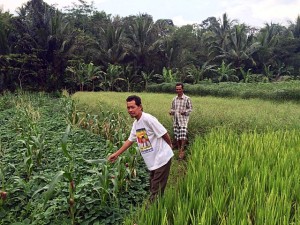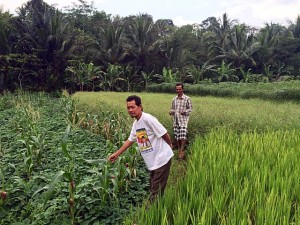By Lina Tennhardt and Sacha Amaruzaman, originally published at ICRAF’s Agroforestry World Blog

Researchers have found that smallholders participating in a payments for ecosystem services (PES) scheme in Cidanau Watershed, Indonesia had more diverse diets than farmers who weren’t participating. Food security, however, is still an issue for the watershed so promoting agroforestry could not only increase households’ incomes but also improve their nutrition.
Cidanau Watershed in Banten province, Indonesia, is the main source of water for the industrial city of Cilegon. To maintain its water-provisioning function, Forum Komunikasi DAS Cidanau, a multi-stakeholder communication forum in the watershed, facilitated a PES scheme, wherein smallholders who voluntarily adopted sustainable agroforestry practices received annual cash payments from the companies that benefited from the water
Most farmers who joined the PES scheme in Cidanau now practise agroforestry and choose crop diversification over intensification to reduce risks from agricultural challenges, like fluctuating market prices, lack of farming knowledge and migration of the young people to cities. Generally, high agro-diversity, as is expected in such diversified farming systems, results in greater diversity of farmers’ diets and improved nutritional status. However, Banten province, including Cidanau, still reports low nutritional status of the local population. This holds even in the rural areas, where diets are commonly thought to be non-diverse and dependent on their farm produce.

It is in this context that researchers from ICRAF The World Agroforestry Centre and the Technical University of Cologne in Germany conducted a study on food, nutrition and profitability of farming systems in Cidanau Watershed. Supported by the CGIAR Research Program on Forests, Trees and Agroforestry, the study investigated the links between different farming systems, household dietary diversity, including smallholders’ household food consumption, and the profitability of tree- and crop-based farming systems.
Key research questions were: ‘Do agroforestry farmers who receive PES payments make different management decisions for their plots compared to those who don’t? If so, does it lead to higher monetary returns for their households? Also, do households that receive compensation have higher dietary diversity and improved nutritional status than those that are not part of the PES scheme?’
In April 2016, the researchers conducted a survey with smallholding households, both those participating and those not participating in the PES scheme. From seven villages in Cidanau, 45 farmers were interviewed for a farming profitability analysis, while 105 women, mostly wives of farmers, were interviewed regarding their household food consumption.
The preliminary results show that the crop-based farming systems in the area were predominantly rice-based, whereas tree-based systems largely grew clove and ‘melinjo’ (Gnetum gnemon), usually mixed with some ‘petai’(Parkia speciosa), durian, banana and other species. Farming systems widely vary in Cidanau, as each farmer can have different tree and crop combinations in their plots. Yields and farm gate prices of commodities also have a very wide range.
On average, farmers receiving compensation have a higher tree density on their plots. However, results also indicated that food security was still an issue throughout the watershed. More than half of all households fear not having enough food, while some go to bed hungry.
Diets throughout the watershed are quite non-diverse without taking into consideration the farming systems they employ. The researchers also found self-generated produce plays only a minor role in food consumption while bought and processed foods are highly important for households’ dietary diversity. Households that joined the PES scheme had more varied dietary patterns and higher consumption of meat and carbohydrates.
A strategy to increase household incomes and purchasing power is needed to improve people’s nutritional status in Cidanau. Increasing yields and consequently, profits by improved plot management or promotion of planting crops in the agroforest understorey could be easy and inexpensive starting points for the smallholders.











